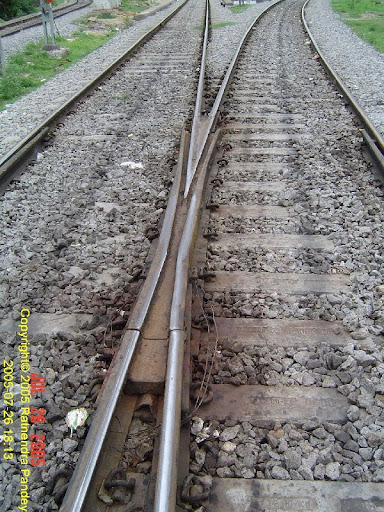What part of the turnout is considered a frog. I hear everyone talking about powering the frog in a turnout, but don’t know exactly what section is the frog. Sorry if this is a stupid question, but I am not really sure.
The link below should answer your question:
http://www.teamdigital1.com/applications/tech_talk/frog_power.html
Chuck
It’s a little green amphiban that hops around and goes ‘ribbit’, but that’s not important right now. [(-D] [%-)] [(-D]
What Chuck said.
–Randy
The search engine can be your friend.Knowing the parts of a switch will become more important as you go with building a layout.
Wait until you need to know about points, and diverging track.[:D]
Amplifying on the other Chuck’s link, a frog is the arrangement of rails that allows a wheel flange to cross through another rail. A simple turnout has one. A crossing has four, one at each angle of the diamond.
In prototype practice, frogs are steel castings of appropriate shape, usually composed of special alloy for high wear resistance. The name probably originated with the skinny X shape of that casting.
In model practice, frogs are frequently separate plastic or metal castings. Metal frogs may be powered or unpowered. If you have rolling stock with short pickup wheelbases, powered frogs are a necessity. Most modern diesel locomotive models pick up from all wheels, and don’t need to have the usual commercial turnout frogs powered.
Chuck (Modeling Central Japan in September, 1964 - with powered frogs)
Woodman.
Beside being green and hops into the pond when you want to catch them it is also the joint where a flanged wheel crosses another rail. Turnouts, crossings, slips and other special work all have frogs. There are also re-rail frogs used to re-rail a derailed wheel. Like the non green frog it allows a flanged wheel to cross a rail. There are many styles of frogs. Rail-bound, cast manganese, guarded, UN-guarded, flange bearing, and more. Google rail frog and see what you get.
Pete
I can truthfully say I’ve cut the nuts off a frog with a blowtorch.
Did it jump up and bite you?
A welder who got burned on the job gave that explanation to the (female) company nurse when he sought treatment for the resultant burn. She filed a complaint that he had, “Offended her by using inappropriate language.”
(She probably thinks that prop wash is special soap solution used for cleaning mine timbers in place.)
Chuck (Ex aircraft mechanic modeling Central Japan in September, 1964)
As noted earlier, it’s the spot where one rail jumps over the other one.
Blow torches aren’t typically involved but it does induce a better Jump. [:-^]
It’s the big cast piece in the middle:

This will tell you more than you really want to know - but it does give some idea as to why a ‘frog’ is called a ‘frog.’